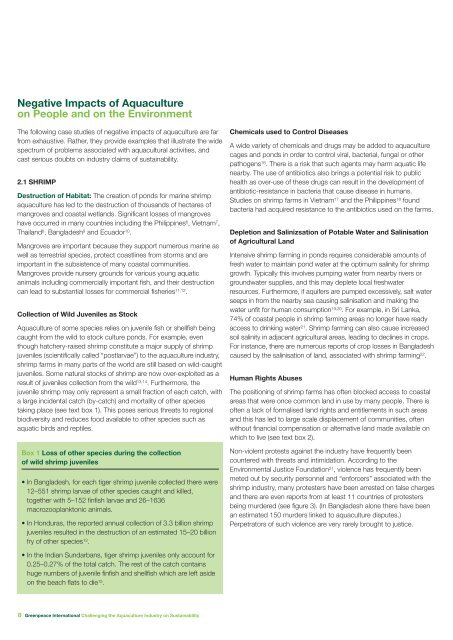Challenging the Aquaculture Industry on Sustainability-Greenpeace ...
Challenging the Aquaculture Industry on Sustainability-Greenpeace ...
Challenging the Aquaculture Industry on Sustainability-Greenpeace ...
You also want an ePaper? Increase the reach of your titles
YUMPU automatically turns print PDFs into web optimized ePapers that Google loves.
Negative Impacts of <str<strong>on</strong>g>Aquaculture</str<strong>on</strong>g><br />
<strong>on</strong> People and <strong>on</strong> <str<strong>on</strong>g>the</str<strong>on</strong>g> Envir<strong>on</strong>ment<br />
The following case studies of negative impacts of aquaculture are far<br />
from exhaustive. Ra<str<strong>on</strong>g>the</str<strong>on</strong>g>r, <str<strong>on</strong>g>the</str<strong>on</strong>g>y provide examples that illustrate <str<strong>on</strong>g>the</str<strong>on</strong>g> wide<br />
spectrum of problems associated with aquacultural activities, and<br />
cast serious doubts <strong>on</strong> industry claims of sustainability.<br />
2.1 SHRIMP<br />
Destructi<strong>on</strong> of Habitat: The creati<strong>on</strong> of p<strong>on</strong>ds for marine shrimp<br />
aquaculture has led to <str<strong>on</strong>g>the</str<strong>on</strong>g> destructi<strong>on</strong> of thousands of hectares of<br />
mangroves and coastal wetlands. Significant losses of mangroves<br />
have occurred in many countries including <str<strong>on</strong>g>the</str<strong>on</strong>g> Philippines 6 , Vietnam 7 ,<br />
Thailand 8 , Bangladesh 9 and Ecuador 10 .<br />
Mangroves are important because <str<strong>on</strong>g>the</str<strong>on</strong>g>y support numerous marine as<br />
well as terrestrial species, protect coastlines from storms and are<br />
important in <str<strong>on</strong>g>the</str<strong>on</strong>g> subsistence of many coastal communities.<br />
Mangroves provide nursery grounds for various young aquatic<br />
animals including commercially important fish, and <str<strong>on</strong>g>the</str<strong>on</strong>g>ir destructi<strong>on</strong><br />
can lead to substantial losses for commercial fisheries 11,12 .<br />
Collecti<strong>on</strong> of Wild Juveniles as Stock<br />
<str<strong>on</strong>g>Aquaculture</str<strong>on</strong>g> of some species relies <strong>on</strong> juvenile fish or shellfish being<br />
caught from <str<strong>on</strong>g>the</str<strong>on</strong>g> wild to stock culture p<strong>on</strong>ds. For example, even<br />
though hatchery-raised shrimp c<strong>on</strong>stitute a major supply of shrimp<br />
juveniles (scientifically called “postlarvae”) to <str<strong>on</strong>g>the</str<strong>on</strong>g> aquaculture industry,<br />
shrimp farms in many parts of <str<strong>on</strong>g>the</str<strong>on</strong>g> world are still based <strong>on</strong> wild-caught<br />
juveniles. Some natural stocks of shrimp are now over-exploited as a<br />
result of juveniles collecti<strong>on</strong> from <str<strong>on</strong>g>the</str<strong>on</strong>g> wild 13,14 . Fur<str<strong>on</strong>g>the</str<strong>on</strong>g>rmore, <str<strong>on</strong>g>the</str<strong>on</strong>g><br />
juvenile shrimp may <strong>on</strong>ly represent a small fracti<strong>on</strong> of each catch, with<br />
a large incidental catch (by-catch) and mortality of o<str<strong>on</strong>g>the</str<strong>on</strong>g>r species<br />
taking place (see text box 1). This poses serious threats to regi<strong>on</strong>al<br />
biodiversity and reduces food available to o<str<strong>on</strong>g>the</str<strong>on</strong>g>r species such as<br />
aquatic birds and reptiles.<br />
Box 1 Loss of o<str<strong>on</strong>g>the</str<strong>on</strong>g>r species during <str<strong>on</strong>g>the</str<strong>on</strong>g> collecti<strong>on</strong><br />
of wild shrimp juveniles<br />
• In Bangladesh, for each tiger shrimp juvenile collected <str<strong>on</strong>g>the</str<strong>on</strong>g>re were<br />
12–551 shrimp larvae of o<str<strong>on</strong>g>the</str<strong>on</strong>g>r species caught and killed,<br />
toge<str<strong>on</strong>g>the</str<strong>on</strong>g>r with 5–152 finfish larvae and 26–1636<br />
macrozooplankt<strong>on</strong>ic animals.<br />
• In H<strong>on</strong>duras, <str<strong>on</strong>g>the</str<strong>on</strong>g> reported annual collecti<strong>on</strong> of 3.3 billi<strong>on</strong> shrimp<br />
juveniles resulted in <str<strong>on</strong>g>the</str<strong>on</strong>g> destructi<strong>on</strong> of an estimated 15–20 billi<strong>on</strong><br />
fry of o<str<strong>on</strong>g>the</str<strong>on</strong>g>r species 13 .<br />
Chemicals used to C<strong>on</strong>trol Diseases<br />
A wide variety of chemicals and drugs may be added to aquaculture<br />
cages and p<strong>on</strong>ds in order to c<strong>on</strong>trol viral, bacterial, fungal or o<str<strong>on</strong>g>the</str<strong>on</strong>g>r<br />
pathogens 16 . There is a risk that such agents may harm aquatic life<br />
nearby. The use of antibiotics also brings a potential risk to public<br />
health as over-use of <str<strong>on</strong>g>the</str<strong>on</strong>g>se drugs can result in <str<strong>on</strong>g>the</str<strong>on</strong>g> development of<br />
antibiotic-resistance in bacteria that cause disease in humans.<br />
Studies <strong>on</strong> shrimp farms in Vietnam 17 and <str<strong>on</strong>g>the</str<strong>on</strong>g> Philippines 18 found<br />
bacteria had acquired resistance to <str<strong>on</strong>g>the</str<strong>on</strong>g> antibiotics used <strong>on</strong> <str<strong>on</strong>g>the</str<strong>on</strong>g> farms.<br />
Depleti<strong>on</strong> and Salinizsati<strong>on</strong> of Potable Water and Salinisati<strong>on</strong><br />
of Agricultural Land<br />
Intensive shrimp farming in p<strong>on</strong>ds requires c<strong>on</strong>siderable amounts of<br />
fresh water to maintain p<strong>on</strong>d water at <str<strong>on</strong>g>the</str<strong>on</strong>g> optimum salinity for shrimp<br />
growth. Typically this involves pumping water from nearby rivers or<br />
groundwater supplies, and this may deplete local freshwater<br />
resources. Fur<str<strong>on</strong>g>the</str<strong>on</strong>g>rmore, if aquifers are pumped excessively, salt water<br />
seeps in from <str<strong>on</strong>g>the</str<strong>on</strong>g> nearby sea causing salinisati<strong>on</strong> and making <str<strong>on</strong>g>the</str<strong>on</strong>g><br />
water unfit for human c<strong>on</strong>sumpti<strong>on</strong> 19,20 . For example, in Sri Lanka,<br />
74% of coastal people in shrimp farming areas no l<strong>on</strong>ger have ready<br />
access to drinking water 21 . Shrimp farming can also cause increased<br />
soil salinity in adjacent agricultural areas, leading to declines in crops.<br />
For instance, <str<strong>on</strong>g>the</str<strong>on</strong>g>re are numerous reports of crop losses in Bangladesh<br />
caused by <str<strong>on</strong>g>the</str<strong>on</strong>g> salinisati<strong>on</strong> of land, associated with shrimp farming 22 .<br />
Human Rights Abuses<br />
The positi<strong>on</strong>ing of shrimp farms has often blocked access to coastal<br />
areas that were <strong>on</strong>ce comm<strong>on</strong> land in use by many people. There is<br />
often a lack of formalised land rights and entitlements in such areas<br />
and this has led to large scale displacement of communities, often<br />
without financial compensati<strong>on</strong> or alternative land made available <strong>on</strong><br />
which to live (see text box 2).<br />
N<strong>on</strong>-violent protests against <str<strong>on</strong>g>the</str<strong>on</strong>g> industry have frequently been<br />
countered with threats and intimidati<strong>on</strong>. According to <str<strong>on</strong>g>the</str<strong>on</strong>g><br />
Envir<strong>on</strong>mental Justice Foundati<strong>on</strong> 21 , violence has frequently been<br />
meted out by security pers<strong>on</strong>nel and “enforcers” associated with <str<strong>on</strong>g>the</str<strong>on</strong>g><br />
shrimp industry, many protesters have been arrested <strong>on</strong> false charges<br />
and <str<strong>on</strong>g>the</str<strong>on</strong>g>re are even reports from at least 11 countries of protesters<br />
being murdered (see figure 3). (In Bangladesh al<strong>on</strong>e <str<strong>on</strong>g>the</str<strong>on</strong>g>re have been<br />
an estimated 150 murders linked to aquaculture disputes.)<br />
Perpetrators of such violence are very rarely brought to justice.<br />
• In <str<strong>on</strong>g>the</str<strong>on</strong>g> Indian Sundarbans, tiger shrimp juveniles <strong>on</strong>ly account for<br />
0.25–0.27% of <str<strong>on</strong>g>the</str<strong>on</strong>g> total catch. The rest of <str<strong>on</strong>g>the</str<strong>on</strong>g> catch c<strong>on</strong>tains<br />
huge numbers of juvenile finfish and shellfish which are left aside<br />
<strong>on</strong> <str<strong>on</strong>g>the</str<strong>on</strong>g> beach flats to die 15 .<br />
8 <strong>Greenpeace</strong> Internati<strong>on</strong>al <str<strong>on</strong>g>Challenging</str<strong>on</strong>g> <str<strong>on</strong>g>the</str<strong>on</strong>g> <str<strong>on</strong>g>Aquaculture</str<strong>on</strong>g> <str<strong>on</strong>g>Industry</str<strong>on</strong>g> <strong>on</strong> <strong>Sustainability</strong>












